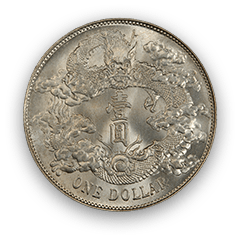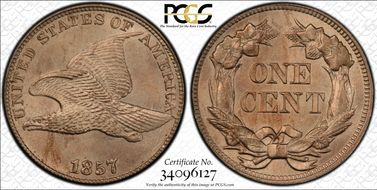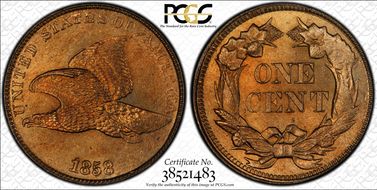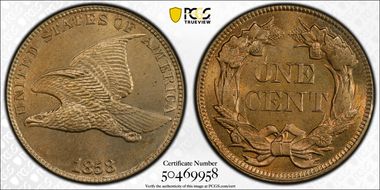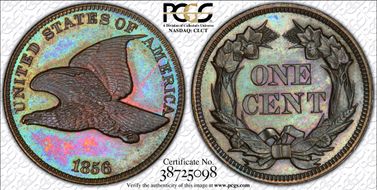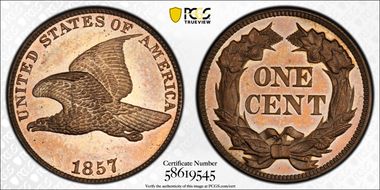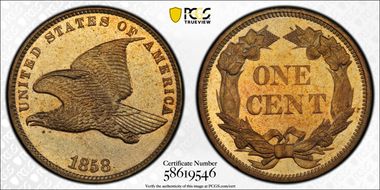Aurelian Select Acquisitions 的钱币相册
1856 1C MS66 PCGS EEPS, Snow-3 Die Variety, Die Stage A. Provenance: Ex Joseph P. Gorrell Collection and Greensboro Collection. This striking 1856 Flying Eagle cent, the first coin to receive a Eagle Eye Photo Seal (associated with previous cert #9949371 - see photo with Old Green Holder), possesses exceptional visual appeal that even surpasses its cert photo. It ranks among the finest known examples of the Snow-3 die variety, one of only two graded MS66 by PCGS (a third MS66 is actually a Snow-5, and Flying Eagle expert Rick Snow has determined all Snow-5s are actually Proofs), and it may very well be the finest MS Snow-3, as it is the only MS Snow-3 which has always been graded MS66. While the other MS66 Snow-3 achieved a record auction price of $343,125 in 2023, this particular coin was acquired for a remarkable $192,000 (Heritage - Nov 21, 2024 - lot #3624). This favorable acquisition price may have been influenced by collector interest in a higher-graded (PR67+) Proof-attributed Snow-3 example sold later the same day. Notably, this MS66 coin previously sold for $172,500 over two decades prior (Heritage - Jan 7, 2004 - lot #2010). With inflation, that $172,500 in 2004 would be $295,000 in 2025 (based on https://www.usinflationcalculator.com/), demonstrating that the $192,000 was a complete steal. The Snow-3 variety, along with the Snow-1, represents the "Original Striking" of 1856 Flying Eagles (Snow-5s may also have been part of the Original striking). These important Original coins were presented to key U.S. officials to advocate for the Small Cents Act of 1857. The Original Striking sequence began with rare Snow-1 Proofs, followed by the unique "Bluebird" Proof Snow-3 (also Die Stage A), and then the Mint State Snow-3s, including this Die Stage A specimen. Characteristic of all Snow-3 coins (excluding the Proof "Bluebird"), this example exhibits a clear weakness of strike, particularly noticeable on the eagle's breast feathers when compared to the sharper detail of the "Bluebird" (cert #38725098). This weakness of strike confirms its Mint State designation and offers a direct point of comparison with the Proof example of the same die variety. Die Stage A coins, identified by diagonal die lines through UNITED, have Proof-like medium mirrors. However, the mirrors on this coin are much less pronounced than they are on the other MS66 Snow-3 (cert #81467176) and the fields of this coin are approaching the satiny luster characteristic of die stage B. In addition, the weakness of strike is much more obvious here than it is with the other MS66 Snow-3 (cert #81467176). For these reasons, it's pretty obvious this coin is not a Proof.
1856 1C MS66 PCGS EEPS, Snow-3 Die Variety, Die Stage A. Provenance: Ex Joseph P. Gorrell Collection and Greensboro Collection. This striking 1856 Flying Eagle cent, the first coin to receive a Eagle Eye Photo Seal (associated with previous cert #9949371 - see photo with Old Green Holder), possesses exceptional visual appeal that even surpasses its cert photo. It ranks among the finest known examples of the Snow-3 die variety, one of only two graded MS66 by PCGS (a third MS66 is actually a Snow-5, and Flying Eagle expert Rick Snow has determined all Snow-5s are actually Proofs), and it may very well be the finest MS Snow-3, as it is the only MS Snow-3 which has always been graded MS66. While the other MS66 Snow-3 achieved a record auction price of $343,125 in 2023, this particular coin was acquired for a remarkable $192,000 (Heritage - Nov 21, 2024 - lot #3624). This favorable acquisition price may have been influenced by collector interest in a higher-graded (PR67+) Proof-attributed Snow-3 example sold later the same day. Notably, this MS66 coin previously sold for $172,500 over two decades prior (Heritage - Jan 7, 2004 - lot #2010). With inflation, that $172,500 in 2004 would be $295,000 in 2025 (based on https://www.usinflationcalculator.com/), demonstrating that the $192,000 was a complete steal. The Snow-3 variety, along with the Snow-1, represents the "Original Striking" of 1856 Flying Eagles (Snow-5s may also have been part of the Original striking). These important Original coins were presented to key U.S. officials to advocate for the Small Cents Act of 1857. The Original Striking sequence began with rare Snow-1 Proofs, followed by the unique "Bluebird" Proof Snow-3 (also Die Stage A), and then the Mint State Snow-3s, including this Die Stage A specimen. Characteristic of all Snow-3 coins (excluding the Proof "Bluebird"), this example exhibits a clear weakness of strike, particularly noticeable on the eagle's breast feathers when compared to the sharper detail of the "Bluebird" (cert #38725098). This weakness of strike confirms its Mint State designation and offers a direct point of comparison with the Proof example of the same die variety. Die Stage A coins, identified by diagonal die lines through UNITED, have Proof-like medium mirrors. However, the mirrors on this coin are much less pronounced than they are on the other MS66 Snow-3 (cert #81467176) and the fields of this coin are approaching the satiny luster characteristic of die stage B. In addition, the weakness of strike is much more obvious here than it is with the other MS66 Snow-3 (cert #81467176). For these reasons, it's pretty obvious this coin is not a Proof.
1856 1C MS66 PCGS EEPS, Snow-3 Die Variety, Die Stage A. Provenance: Ex Joseph P. Gorrell Collection and Greensboro Collection. This striking 1856 Flying Eagle cent, the first coin to receive a Eagle Eye Photo Seal (associated with previous cert #9949371 - see photo with Old Green Holder), possesses exceptional visual appeal that even surpasses its cert photo. It ranks among the finest known examples of the Snow-3 die variety, one of only two graded MS66 by PCGS (a third MS66 is actually a Snow-5, and Flying Eagle expert Rick Snow has determined all Snow-5s are actually Proofs), and it may very well be the finest MS Snow-3, as it is the only MS Snow-3 which has always been graded MS66. While the other MS66 Snow-3 achieved a record auction price of $343,125 in 2023, this particular coin was acquired for a remarkable $192,000 (Heritage - Nov 21, 2024 - lot #3624). This favorable acquisition price may have been influenced by collector interest in a higher-graded (PR67+) Proof-attributed Snow-3 example sold later the same day. Notably, this MS66 coin previously sold for $172,500 over two decades prior (Heritage - Jan 7, 2004 - lot #2010). With inflation, that $172,500 in 2004 would be $295,000 in 2025 (based on https://www.usinflationcalculator.com/), demonstrating that the $192,000 was a complete steal. The Snow-3 variety, along with the Snow-1, represents the "Original Striking" of 1856 Flying Eagles (Snow-5s may also have been part of the Original striking). These important Original coins were presented to key U.S. officials to advocate for the Small Cents Act of 1857. The Original Striking sequence began with rare Snow-1 Proofs, followed by the unique "Bluebird" Proof Snow-3 (also Die Stage A), and then the Mint State Snow-3s, including this Die Stage A specimen. Characteristic of all Snow-3 coins (excluding the Proof "Bluebird"), this example exhibits a clear weakness of strike, particularly noticeable on the eagle's breast feathers when compared to the sharper detail of the "Bluebird" (cert #38725098). This weakness of strike confirms its Mint State designation and offers a direct point of comparison with the Proof example of the same die variety. Die Stage A coins, identified by diagonal die lines through UNITED, have Proof-like medium mirrors. However, the mirrors on this coin are much less pronounced than they are on the other MS66 Snow-3 (cert #81467176) and the fields of this coin are approaching the satiny luster characteristic of die stage B. In addition, the weakness of strike is much more obvious here than it is with the other MS66 Snow-3 (cert #81467176). For these reasons, it's pretty obvious this coin is not a Proof.
1857 1C MS65+ PCGS EEPS Snow-9 Obv. Clash w/50C,FS-402. Was MS66 NGC (Cert #: 3169246-001) when it was auctioned by Bowers & Merena at the January 2011 Tampa Bay Rarities Sale (lot #102).
1858/7 1C MS65 PCGS EEPS, Snow-1 Die Variety, Die Stage A. Provenance: Ex Doug Wright Collection. This fascinating 1858/7 Flying Eagle cent showcases a notable minting anomaly: the digit "8" in the date is struck over a "7," creating a distinct and collectible variety. This particular example is from Die Stage A of the Snow-1 variety. Of all known 1858/7 Snow-1 cents designated 'STRONG', only four have achieved a grade of MS65 or higher in Die Stage A (there are also some less desirable ones labelled 'STRONG', but which are actually die stage B or later). Adding to its desirability, only one of these four finest Die Stage A examples boasts a CAC. This often means collectors seeking a CAC-endorsed 1858/7 Snow-1 must choose between examples designated "Weak" or those of the much less desirable "Strong" Die Stage B. This MS65 specimen realized $49,200 at auction recently (Heritage - Feb 27, 2024 - lot #3016), having previously sold for $70,500 in 2013 (Heritage - Apr 25, 2013 - lot #4124).
1858 (Small Letters) 1C MS65 PCGS CAC. The scarcer Open E variety.
1858 (Small Letters) 1C MS65 PCGS CAC. The scarcer Open E variety.
1858 (Small Letters) 1C MS65 PCGS CAC. The scarcer Open E variety.
1858 (Small Letters) 1C MS65 PCGS CAC. The scarcer Open E variety.
1856 1C, PR66 PCGS CAC EEPS, Snow-3 Die Variety, Die Stage A. Provenance: Ex collections of Blay, Fore, and Wright. This coin is a numismatic treasure of exceptional rarity and historical significance! Affectionately nicknamed "The Bluebird," this 1856 Flying Eagle cent stands alone as the only known example of the coveted Snow-3 die variety universally recognized as a true Proof striking. While all other Snow-3 specimens exhibit tell-tale signs of a less-than-perfect strike, demonstrating they are actually Mint State coins, this remarkable piece boasts a razor-sharp strike across all its devices! The intensely mirrored fields, a hallmark often associated with Proof coinage, are particularly striking on this specimen. However, it’s not the mirrored fields that distinguishes this coin as a Proof, since even some MS Snow-3s of Die Stage A exhibit proof-like fields, due to the fact that the Snow-3 die pair was polished. The Snow-3 variety holds a pivotal place in American numismatic history. Along with the Snow-1 die variety, coins struck from these dies represent the "Original Striking" (Snow-5s may also have been part of the Original striking). These Originals were the very coins presented to key figures, including members of the U.S. Congress and President of the United States, to garner support for the Small Cents Act of 1857. The Snow-3 coins were produced across three distinct die stages (A, B, and C). The fact that this coin exhibits Die Stage A (identified by diagonal die lines through UNITED) is crucial evidence confirming its status as an "Original" striking, definitively ruling out the possibility of it being a later restrike. Consider the rarity: This "Bluebird" stands as the sole undisputed Proof Original of the Snow-3 variety. This singular status elevates its importance even beyond the finest MS66 PCGS CAC EEPS Snow-3, since there are hundreds of MS Snow-3s, but only one Proof Snow-3. This coin is not merely a beautiful artifact; it is a tangible link to a pivotal moment in the evolution of American coinage, a testament to the artistry of early die preparation, and an unparalleled rarity within its specific die variety.
1857 1C PR64+CAM PCGS CAC EEPS, PR3 Die Variety. Provenance: Ex Screaming Eagles and Wright. This 1857 Flying Eagle cent, graded PR64+CAM with a CAC endorsement, is a spectacular example of a rare proof issue. A striking coin with deeply mirrored fields and fully frosted devices, it possesses an amazing eye appeal that truly sets it apart. While Mint State 1857 Flying Eagle cents are relatively common, the total mintage for all 1857 Proof varieties is exceptionally low, estimated by numismatic expert Rick Snow to be as few as 50 pieces. This coin is definitively identified as the PR3 die variety by a key diagnostic: a bold diagonal die file mark above the "N" in "UNITED." This specific marker confirms its status as a genuine proof, a crucial distinction given that many mint-state coins are often misattributed due to their proof-like fields. Considering CAC-endorsed examples, this coin is the sole one graded PR64+CAM, with only a handful of examples graded higher (3 PR65CAM, 1 PR66, and 1 PR66CAM).
1858 (Small Letters) 1C PR65 PCGS CAC EEPS, PR3 Die Variety. Provenance: Ex Screaming Eagles and Bob Travis. This 1858 Flying Eagle cent, graded PR65 with a CAC endorsement, is an exceptional example of a rare proof issue, with only an estimated 200 minted. Identifying a genuine proof strike can be challenging due to the existence of proof-like mint state coins. The obverse die is identified as Obv. 2 by its unique diagnostic feature: a "broken U hub" where the inner serif of the "U" in "UNITED" is missing. Obv 2 is combined with reverse die, T3-B, on the PR3 die pair, but in this case, the reverse die is T3-A (also used on PR2) as determined by a diagonal die line in denticles below the right ribbon end (T3-B is further eliminated as a possibility since the ribbon end is not connected to the denticles). Since T3-A is also used on PR2, some collectors have incorrectly identified their coins as PR2, apparently based upon diagnostics for the T3-A reverse die. But, actually the combination of Obv. 2 with T3-A is what was used to strike the PT9 of the 12-piece pattern set, which were clearly struck as Proofs. But, still one has to be careful, since some such examples have weak strike and are thus not considered Proofs. In this case, the strike is not weak at all. Further evidence it is a Proof is that it was Photo Sealed by numismatic expert, Rick Snow. Although not officially designated a Cameo (CAM), it exhibits strong contrast and eye appeal, with deep, reflective fields and frosted devices that rival many certified Cameo examples. Among all CAC-endorsed coins of this variety, this piece is one of only six graded PR65, with just five coins graded higher (1 PR65CAM, 3 PR66, and 1 PR66CAM).
1858 (Large Letters) 1C PR65 PCGS CAC EEPS, PR1 Die Variety. Provenance: Ex Screaming Eagles and Boulder City. This 1858 Flying Eagle cent, graded PR65 with a CAC endorsement, is an exceptional example of a rare proof issue. This variety is a notable rarity, with an estimated mintage of only 100 proofs and approximately 50 survivors known today. The key to identifying a genuine 1858 Large Letters proof lies in its specific die diagnostics. Unlike the more common mint state coins which are often mistaken for proofs, this coin is confirmed as the sole proof die variety (PR1) by a combination of subtle markers: 1) Date slants up and to the right 2) Very minor doubling on "UNI" of "UNITED" 3) Diagonal die file marks in the denticles below the "18" and "58" in the date 4) A minute die file mark on the reverse, located just to the left of the 12 o'clock position. Considering CAC-endorsed examples, there are only five other CAC-endorsed coins sharing its PR65 grade and six graded higher (1 PR65+, 3 PR65+CAM, 2 PR66CAM).

